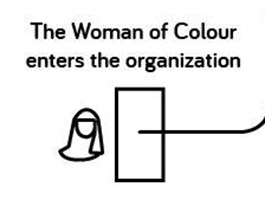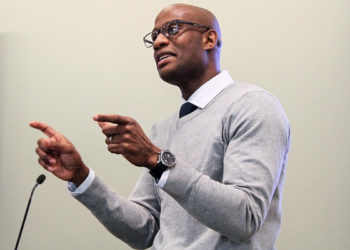As scholarly communicators, we know that we learn from each other and about each other through reading. There is no shortage of books about racism and anti-racism. Yesterday and today we have featured reviews of books for your consideration in this time of listening and reflection. Please also read last week’s statement from the SSP Board of Directors and Co-Chairs of the Diversity, Equity & Inclusion Committee, “Reaffirming our Commitment to Diversity, Equity, and Inclusion.”
Nadia Dawood: I’m Still Here: Black Dignity in a World Made for Whiteness, by Austin Channing Brown, opens with “White people can be exhausting”. Get ready for a raw, real, and unapologetic delivery from an author who does not sidestep the uncomfortable conversations 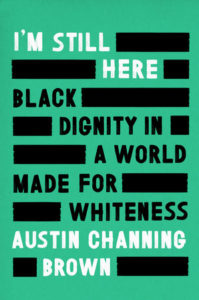 about racism in America.
about racism in America.
Grounded in her Christian beliefs, Austin takes you on a journey through her childhood spent in predominantly White spaces to womanhood. The memoir begins with her first encounter with the concept of race. At 8, she learns that her parents chose her name, hoping that people would believe she was a White male, allowing her a chance at an interview.
In a quote from the book, she says, “Whiteness wants enough Blackness to affirm the goodness of whiteness, the progressiveness of whiteness, the openheartedness of whiteness. Whiteness like a trickle of Blackness, but only that which can be controlled.” Austin does not hold back about the microaggressions at work and in the professional world. She surfaces the reality that diversity, equity, and inclusion (DEI) efforts in professional settings are only half baked because many organizations are concerned about statistics and mission statements but not with giving people of color a seat at the table.
Although a qualified authority figure at work, she is Black, a woman, and a Christian, consequently it seems unacceptable to express any form of anger. In the face of confrontations, she is reminded time and time again of White fragility. She painstakingly keeps composure and patience while denying her emotions and leaving her humanity behind. An essay by Audre Lorde, a famous writer, and activist, led her to the realization that ‘creative anger’ allows people to visualize a better world; one that exists without racial injustice. She explains how anger is what empowered her to put pen to paper and connect with others facing similar challenges.
Austin courageously opens your eyes to the habitancy of White supremacy and White privilege. You will feel the weight and defeat of the dehumanizing experiences people of color are faced with every day like being feared, ignored, questioned, yelled at, and referred to in the third person.
I listened to the book voiced by the author herself in the audiobook version and ended up replaying chapters a few times over because her words were so powerful and prophetic. I would recommend this book to those committed to self-education about racial justice. Prepare to accept the truth that racial bias is more present than ever, and the current landscape is still far from diversity, equity, and inclusion. There is much work to be done.
Sylvia Izzo Hunter: The first thing to clarify about White Fragility by Robin DiAngelo is that it’s a book by a White person, targeted to other White people.
This has two major implications. The first is that it’s a good place to start for White people who want to do a better job of pushing back against systemic racism. The second is that it needs to be where you start, not as far as you go.
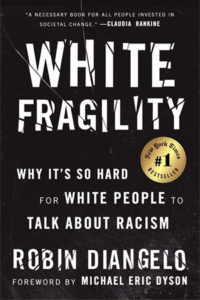 DiAngelo works in diversity and anti-racism training, and her book comes out of that work. “White fragility” is her term for the instinctive but maladaptive ways in which White people react to being told that something they believe, something they’ve said, or something they’ve done is problematic, including denial, defensiveness, and whataboutism. Thanks to many years of experience in confronting White people with their internalized racism, DiAngelo has a wealth of anecdotes to draw on, and if after a while they all start to sound the same … well, she is, after all, identifying a pattern of behavior.
DiAngelo works in diversity and anti-racism training, and her book comes out of that work. “White fragility” is her term for the instinctive but maladaptive ways in which White people react to being told that something they believe, something they’ve said, or something they’ve done is problematic, including denial, defensiveness, and whataboutism. Thanks to many years of experience in confronting White people with their internalized racism, DiAngelo has a wealth of anecdotes to draw on, and if after a while they all start to sound the same … well, she is, after all, identifying a pattern of behavior.
In an early chapter, DiAngelo addresses all the White people who think they’re different: But I have people of color in my family! But I live in a diverse city! But I’m from Canada! and so on. (I am from Canada, and I’m here to tell you that as a country, we are just as racist as the United States — our racism just looks and sounds a bit different.) Perhaps the most important takeaway from White Fragility is that racism and White supremacy — by which DiAngelo means the way American society is structured to benefit White people — isn’t so much the things we do as the water we swim in.
DiAngelo identifies several ways in which the ways we think about racism allow us to deny or defend our own problematic words and actions, including the idea that racism is intentional (leading to defenses like “but I didn’t mean it that way!”), the notion of color-blindedness (“I don’t see color!” or “I don’t care if he’s White, Black, or purple polka-dotted!”), and the “good/bad binary,” that is, the idea that racism is bad (and racists are bad), so if someone is a good person, their words or actions “can’t be racist.” (This last idea is one I had previously been articulating to myself as the difference between saying “that thing you said was racist” and saying “you are a racist.” DiAngelo’s view is that we’re all racist, because humans are social animals and we live in a racist society.)
I appreciated White Fragility for telling it like it is to well-meaning White people who want to do better. Since DiAngelo tells readers over and over again — rightly so — that we need to learn to de-center Whiteness and listen when Black people talk (rather than talking over them, making it about us, assuming we know what they want and need from us, assuming we understand their experience because we were hassled at customs once, and so on), I’m going to end this review where I began it: this book is a good place to start, but if you stop here, with a book for and about White people by a White woman, you’re missing the point.
Where to go from White Fragility? I’d recommend So You Want to Talk about Race (Ijeoma Oluo), The New Jim Crow (Michelle Alexander), Up Ghost River (Edmund Metatawabin), and How to Be an Anti-Racist (Ibram X. Khendi). For interesting historical perspective on current events (at least, it was super interesting to this Canadian/US dual citizen raised in Canada), check out Lies My Teacher Told Me (about US history textbooks) and Lies Across America (about monuments and historical sites) by James K. Loewen. And if, like me, you’re looking to decolonize your fiction reading a little bit, some of my favorite fiction reads by and about people of color over the past year: N.K. Jemisin’s Broken Earth series; A Princess in Theory, by Alyssa Cole; The Marrow Thieves, by Cherie Dimaline; and Children of Blood and Bone, by Tomi Adeyemi.
Patty Baskin: As a member of a staff equity, diversity and inclusion (EDI) committee for my organization, I was encouraged to read Blindspot: Hidden Biases of Good People by Mahzarin Banaji and Anthony Greenwald and found it to be an illuminating and worthwhile 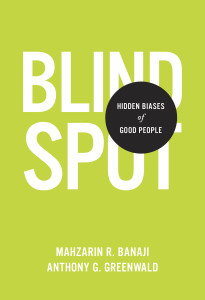 read. There is a blind spot in the retina of each eye, and the authors compare that blind spot to psychological constructs – “mindbugs” or stereotypes that are present in our unconscious minds – that we personally develop over time.
read. There is a blind spot in the retina of each eye, and the authors compare that blind spot to psychological constructs – “mindbugs” or stereotypes that are present in our unconscious minds – that we personally develop over time.
The cultural environments in which we were born have been influenced by centuries of human territorial behavior, during which human minds have been programmed in ways we are not aware of to make social choices that are often biased toward other groups. “Good people” usually believe that we are being fair and objective in our judgments and behavior toward others, not realizing that we carry multiple hidden biases as a result of our exposure since birth to the cultural attitudes that surround us. These hidden or implicit biases pertain to our thoughts about the abilities and character of those of groups different than us – including groups such as those of other races, gender, social class, nationality, and age.
Blindspot attempts to create awareness of these hidden biases. The authors reference the Implicit Association Test from Harvard researchers, a series of self-administered tests (several are included in the book) to help people understand in which areas they have biases; this information thus helps us counteract biases we discover and provide impetus for us to adapt our attitudes and behavior.
Making the biases visible provides to “good people” with good intentions the information they need to challenge themselves to learn more about other groups, change attitudes and behaviors toward them, and make choices that are socially just. The authors of Blindspot challenge readers to identify implicit biases contributing to the institutional racism that prevents equality for Black people and other people of color.
Kate Lavallee: In the past few weeks, I’ve started to see Michelle Alexander’s The New Jim Crow: Mass Incarceration in the Age of Colorblindness on the top of bestseller and “to-read” lists. So, I was surprised when I realized that it was actually published in 2010 and written as a reaction to Barack Obama’s presidency when I, and a lot of the country, thought we finally “made it” to a “post-racial” period in US history. Of course, as Michelle Alexander points out convincingly and masterfully, this is absolutely not the case. A decade later, this book is painfully more important than ever.
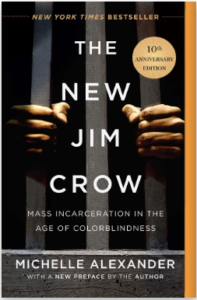 Alexander shows us, very accessibly, how colorblindness has been so detrimental when talking about the criminal justice system, specifically for young Black men. How it has allowed for discrimination to continue through language centered around “crime” for politicians, police officers, and employers to use instead of language centered around race. It is no longer legally or socially acceptable to use skin color to discriminate, but it is completely legal to treat convicted felons as a second-class group of people. Alexander explains how, through the modern justice system, we have “not ended racial caste in America; we have merely redesigned it.”
Alexander shows us, very accessibly, how colorblindness has been so detrimental when talking about the criminal justice system, specifically for young Black men. How it has allowed for discrimination to continue through language centered around “crime” for politicians, police officers, and employers to use instead of language centered around race. It is no longer legally or socially acceptable to use skin color to discriminate, but it is completely legal to treat convicted felons as a second-class group of people. Alexander explains how, through the modern justice system, we have “not ended racial caste in America; we have merely redesigned it.”
She sums up this new racial caste system in three stages. It begins with the War on Drugs, which has resulted in a mass rounding-up of young Black men from inner cities and sending them to prison. Once arrested, the second stage of discrimination begins. Alexander teaches us that the real justice system looks nothing like what we see on TV. By not allowing people to get fair representation or have their rights read to them, even innocent people continuously take plea bargains that, on the surface, seem to allow them lesser sentences. Since we allow convicted criminals to be treated like a lesser caste, in the third stage, they are now barred for years, and in some cases for life, from government programs, education, housing, and employment. This cycle repeats itself for generations, and young Black men in inner cities are now taught that this is the fate they most likely face.
Alexander points out that in order to fix this, we need to talk about race. To remain colorblind is to remain ignorant. This enlightening call to action is the kind of book that should be mandatory reading for all. This is the kind of book you want to make your “colorblind” relatives read. This is the kind of book we need to understand how the US today has not abolished the racial caste system but has simply given it a new language.
Angela Cochran: I would like to thank our contributors to the book reviews today and yesterday as well as the chairs of the SSP DEI Committee, particularly Damita Snow for helping to recruit reviewers. Writing is a deeply personal experience and we are fortunate as readers to be able to use the narrative form as a way to challenge our beliefs and briefly step into the shoes of others. None of us can put aside who we are and fully experience the world through the eyes of others, but books allow us to imagine the world from another perspective. Non-fiction writing presents us with facts and narratives missing from the mainstream history books of our education. All that said, in this moment of looking for unity around racial justice, reading is the start, not the finish.
Tre Johnson’s Washington Post Op-Ed, “When Black People Are in Pain, White People Just Join Book Clubs,” reminds us that learning and listening is only effective when followed by action. Johnson writes:
The right acknowledgment of black justice, humanity, freedom and happiness won’t be found in your book clubs, protest signs, chalk talks or organizational statements. It will be found in your earnest willingness to dismantle systems that stand in our way — be they at your job, in your social network, your neighborhood associations, your family or your home. It’s not just about amplifying our voices, it’s about investing in them and in our businesses, education, political representation, power, housing and art.
Note: The style manual used for choices such as capitalization of terms is the Diversity Style Guide.
Discussion
1 Thought on "Connecting by Reading: A Selection of Books on Race and Racism, Part 2"
I’m a little behind on my SK reading. Thank you for the reading list (many of which will be making their way into my queue). However, there is a risk of this list giving the impression that racism is a predominantly US issue – which it absolutely is not. For those of us in the UK may I suggest the following additions as a good place to start?
Akala, ‘Natives: Race And Class In The Ruins Of Empire’
Reni Eddo-Lodge, ‘Why I Am No Longer Talking To White People About Race’
Afua Hirsch, ‘Brit:ish: On Race, Identity And Belonging’
David Olusoga, ‘Black and British’
Nikesh Shukla, ‘The Good Immigrant’

